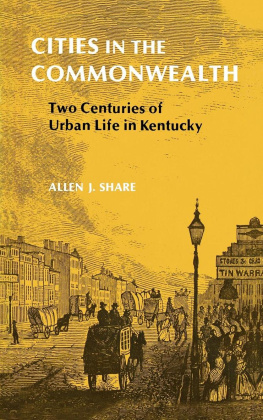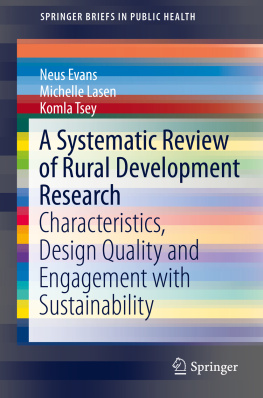THE CITYS HINTERLAND
Perspectives on Rural Policy and Planning
Series Editors:
Andrew Gilg
University of Exeter, UK
Keith Hoggart
Kings College London, UK
Henry Buller
University of Exeter, UK
Owen Furuseth
University of North Carolina, USA
Mark Lapping
University of South Maine, USA
Other titles in the series
Women in Agriculture in the Middle East
Pnina Motzafi-Haller
ISBN 0 7546 1920 6
Winning and Losing
The Changing Geography of Europes Rural Areas
Edited by Doris Schmied
ISBN 0 7546 41015
Critical Studies in Rural Gender Issues
Edited by Jo Little and Carol Morris
ISBN 0 7546 3517 1
Contesting Rurality
Politics in the British Countryside
Michael Woods
ISBN 0 7546 3025 0
Women in the European Countryside
Edited by Henry Buller and Keith Hoggart
ISBN 0 7546 3946 0
Equity, Diversity and Interdependence
Reconnecting Governance and People through Authentic Dialogue
Michael Murray and Brendan Murtagh
ISBN 0 7546 3521 X
The Citys Hinterland
Dynamism and Divergence in Europes Peri-Urban Territories
Edited by
KEITH HOGGART
Kings College London, UK
First published 2005 by Ashgate Publishing
Published 2016 by Routledge
2 Park Square, Milton Park, Abingdon, Oxon OX14 4RN
711 Third Avenue, New York, NY 10017, USA
Routledge is an imprint of the Taylor & Francis Group, an informa business
Copyright 2005 Keith Hoggart
Keith Hoggart has asserted his right under the Copyright, Designs and Patents Act, 1988, to be identified as editor of this work.
All rights reserved. No part of this book may be reprinted or reproduced or utilised in any form or by any electronic, mechanical, or other means, now known or hereafter invented, including photocopying and recording, or in any information storage or retrieval system, without permission in writing from the publishers.
Notice:
Product or corporate names may be trademarks or registered trademarks, and are used only for identification and explanation without intent to infringe.
British Library Cataloguing in Publication Data
The citys hinterland : dynamism and divergence in Europes
peri - urban territories. (Perspectives on rural policy and planning)
1. Rural-urban relations Europe 2. Rural-urban relations
Economic aspects Europe 3. Metropolitan areas Economic
aspects Europe 4. Cities and towns Europe Growth
5. Europe Rural conditions
I. Hoggart, Keith
307.72094
Library of Congress Cataloging-in-Publication Data
The citys hinterland : dynamism and divergence in Europes peri-urban territories edited by Keith Hoggart.
p. cm. -- (Perspectives on rural policy and planning)
Includes index.
ISBN 978-0-7546-4344-9
1. Rural-urban relations--Europe. 2. Metropolitan areas--Europe. 3. Regional planning--Europe. I. Hoggart, Keith. II. Series.
HT384.E852C58 2005
307.74094--dc22
2005022767
ISBN-13: 978 0 7546 4344 9 (hbk)
ISBN-13: 978 1 3156 1476 2 (ebk)
Contents
Keith Hoggart
Vincent Briquel and Jean-Jacques Collicard
3 Commuter Belt Turbulence in a Dynamic Region: The
Case of the Munich City-Region
Claudia Kraemer
Nathalie Bertrand and Emmanuelle George-Marcelpoil
Francisco Entrena
Steven Henderson
Keith Hoggart
List of Figures
List of Tables
List of Contributors
Nathalie Bertrand
Researcher, Cemagref, Centre of Agricultural and Environmental Engineering Research, Grenoble
Vincent Briquel
Researcher, Cemagref, Centre of Agricultural and Environmental Engineering Research, Grenoble
Jean-Jacques Collicard
Researcher, Cemagref, Centre of Agricultural and Environmental Engineering Research, Grenoble
Francisco Entrena
Professor of Rural Sociology and the Structure and Change of Societies, University of Granada
Emmanuelle George-Marcelpoil
Researcher, Cemagref, Centre of Agricultural and Environmental Engineering Research, Grenoble
Steven Henderson
Researcher Associate, Department of Geography, University of Reading
Keith Hoggart
Professor of Geography, Kings College London
Claudia Kraemer
Researcher, Faculty of Spatial Planning, University of Dortmund
Chapter 1
City Hinterlands in European Space
Keith Hoggart
Introduction
The book brings together research in four European countries on the nature and impact on rural areas of linkages with cities. Funded by the European Commission under the Quality of Life and Management of Living Resources Programme, the research for this project was designed to explore a variety of activity sectors and agents in rural zones, with a view to identifying how urban pressure on rural areas produced particular mutations and generated new dynamics of rural change. This book focused on particular aspects of this wider project, with a specific focus on the consequences for employment, housing and services of intensifying rural links with cities. The impetus behind this research was a sense that insufficient attention has been devoted to understanding city hinterlands in Europe. This is an important lapse if we are to grasp positive possibilities for future change in the European space economy. As Berg and associates (1982) recognized more than 20 years ago, Europe has shifted from seeing regional development emerging from differences in sectoral change, to a situation in which new sectoral developments depend on regional specificities. Today, the importance of local/regional institutional thickness, of geographically grounded networks, and of learning regions, are widely recognized as critical to the advancement of local and regional economies (e.g. Morgan, 1997; Keeble et al., 1999; Castells, 2000). This prompts an impetus toward identifying what different geographical contexts embody that stimulates socio-economic change. Of course, before such questions are asked, a primary issue is what kind of geographical focus should attract investigative attention. For some the answer lies in administrative regions, which explains the popularity of studies exploring differences between provincial, (formal) regional or local government areas. Undoubtedly such areas are relevant for some dimensions of human activity. But when it comes to understanding the breadth of human endeavour, activity patterns tend not to be channelled by political boundaries but rather wash over them; they might irritate and try to regulate but political boundaries rarely encompass the geography of socio-economic life (e.g. UK Royal Commission on Local Government in England, 1969). More proximate to real life choices, whether personal or corporate, are interaction systems forged around city-regions. Yet, while city-centred regions dominate large tracts of the European space (Herrschel and Newman, 2002), outdated visions of city-region fortunes being driven simply by events in the core city need discarding (Berry, 1970). It might well be, as Dunford and Perrons (1994) note, that successful regional economies are centred around major cities, but this does not mean the city as such determines the success of the city-region. In an economic climate in which there are concerns about diseconomies from over-congested cities, in which the environment has become a key economic attraction, with the vitality of a region depending upon quality of life considerations, the imagery that rural areas offer a good life, with supportive community cohesion, a lack of social conflict and (relatively) crime-free conditions, means that country areas and rural landscapes have become central to city-region futures (e.g. Keeble




